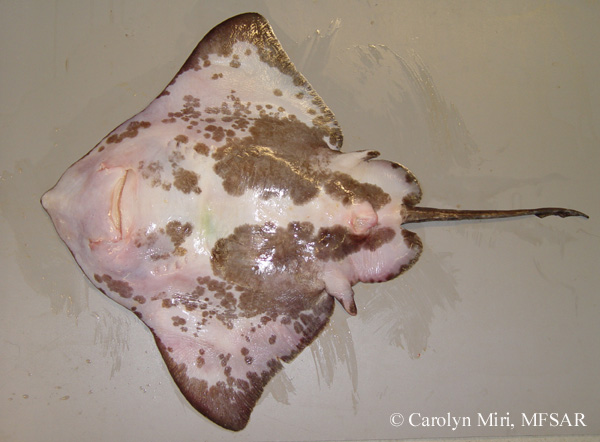Arctic Skate
Amblyraja hyperborea
Description
Of all other northwest Atlantic skates, the Arctic skate - sometimes called the blackbelly skate - most closely resembles the thorny skate (Amblyraja radiata) and the shorttail or Jensen's skate (Amblyraja jenseni). However, it is distinguished from other species, most notably, by its colouration. Whereas the thorny is uniform white on its ventral surface and the shorttail skate is highly blotched, the Arctic skate is either dark on the bottom with distinct light spots, or light on the bottom with dark markings. The dorsal surface of the Arctic skate is dark mouse gray, blue gray or dark brown with small rounded spots. Also different between the thorny skate and the Arctic skate are the thorn pattern and tooth structure. The Arctic skate has many more spines along the midline of the back and tail (22 - 31) than the thorny skate (12 - 19), and has narrow teeth with sharp, central cusps, whereas the thorny skate has flat, pavement-like teeth. On the Arctic skate, the mid-dorsal row of stout thorns extend from the nuchal region to the first dorsal fin, with the thorns close to the pelvic girdle being larger than those along the tail. The tail of the Arctic skate is very short.
Size
The Arctic skate reportedly attains a total maximum size of 87 - 106 cm TL. However, the longest Canadian specimen recorded was only 45 cm TL.
Range
The Arctic skate occurs in cold, polar waters from Baffin Bay (including off Cape Dyer), along the west, south, and east coasts of Greenland and eastward to Iceland and the Barents Sea and northern Norway. Although extremely rare in Canadian waters, sixteen individuals were reportedly captured in Baffin Bay (1948), and a single specimen was reported off Cape Dyer, Baffin Island in 1959, the later being the southernmost record for the Canadian side of the Atlantic. It is possible that in the future, the Arctic skate will be found in the Labrador Sea south of Cape Chidley.
Habitat
This skate is a benthic, bathydemersal species, occurring on the lower continental slope at depths of 140 - 2500 m. The Cape Dyer specimen was caught at 550 m depth at a bottom temperature of 1.16°C. This species appears to prefer polar temperatures from hatching to maturity.
Life History
Unknown
Diet
The exact diet of the Arctic skate is unknown; however, it is thought to feed on a wide variety of benthic organisms.
Reproduction
The Arctic skate is oviparous, laying presumably less than 100 eggs annually. Eggs are incubated successfully and regularly in cold, polar waters as low 0°C. Upon hatching, young have been observed following large objects.
- Date modified:





